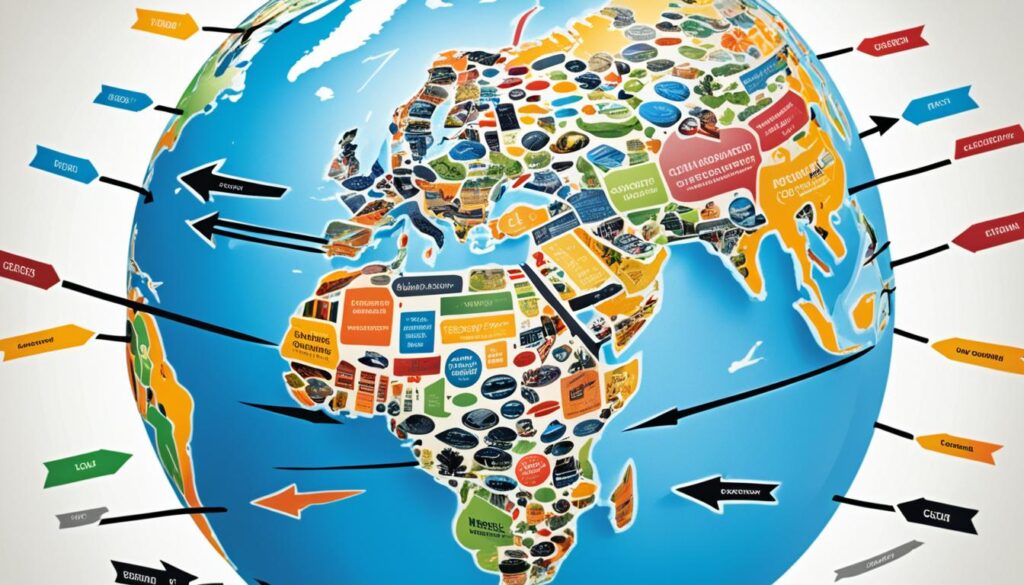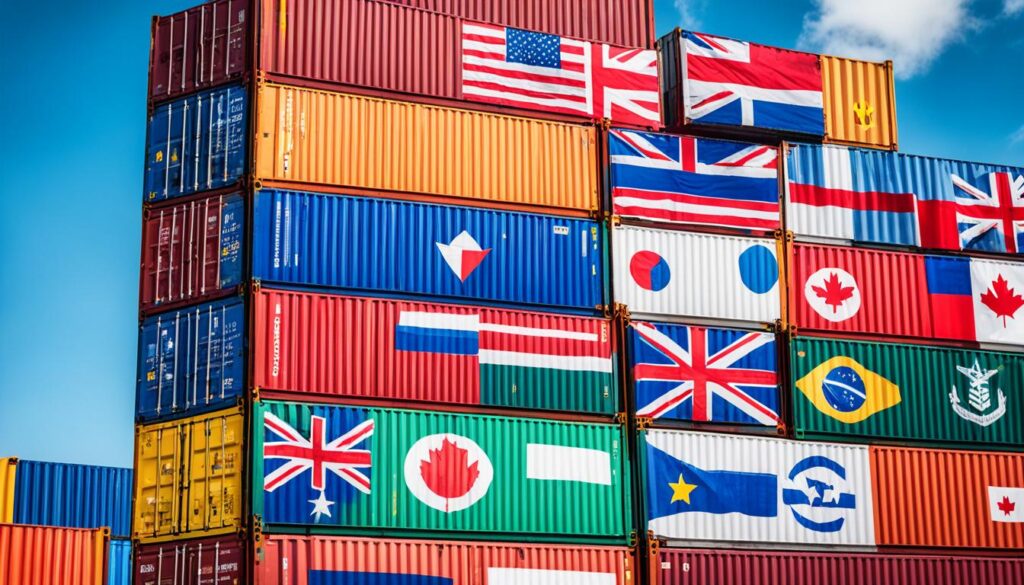Have you ever wondered how global trade works? How do goods and services cross borders, and who are the key players in the import-export business? What factors shape the global supply chain, and how do trade agreements and tariff regulations impact international commerce? In a world driven by cross-border transactions and interconnected economies, understanding global trade dynamics is more important than ever.
Global trade, characterized by the exchange of goods and services across nations, plays a vital role in driving economic growth and development. It involves multiple trading partners, complex networks, and ever-changing market trends. From the major economies like the United States, China, and India, to smaller yet influential players like Japan and South Korea, the interplay of these countries shapes the global trade landscape.
To truly understand global trade, we need to delve into the intricacies of trade networks and explore how they have evolved over time. By analyzing the structural properties of these networks, such as their centrality and reciprocity, we can gain insights into the power dynamics and economic interdependencies among nations. Moreover, understanding the impact of global events on trade networks helps us identify emerging trends and make informed decisions.
Key Takeaways:
- Global trade is a complex web of cross-border transactions and interconnected economies.
- Understanding trade networks and their structural properties provides insights into power dynamics and economic interdependencies among nations.
- Global events can significantly impact trade networks, reshaping market trends and trade relationships.
- Analyzing global trade dynamics is crucial for businesses and policymakers to make informed decisions and adapt to the ever-changing landscape.
- Stay tuned as we unravel the secrets of international commerce and uncover the trends shaping global trade.
The Quest for a Network Perspective on International Trade
The motivation for this study lies in the quest to comprehend international trade from a network perspective. By analyzing trade imbalances, trade dominance, and the impact of political and economic crises, the study offers a fresh lens to understand the dynamics and resilience of trade relationships. The theoretical framework integrates international trade theory, network analysis, time-series analysis, and crisis theory to provide a comprehensive understanding of international trade dynamics.
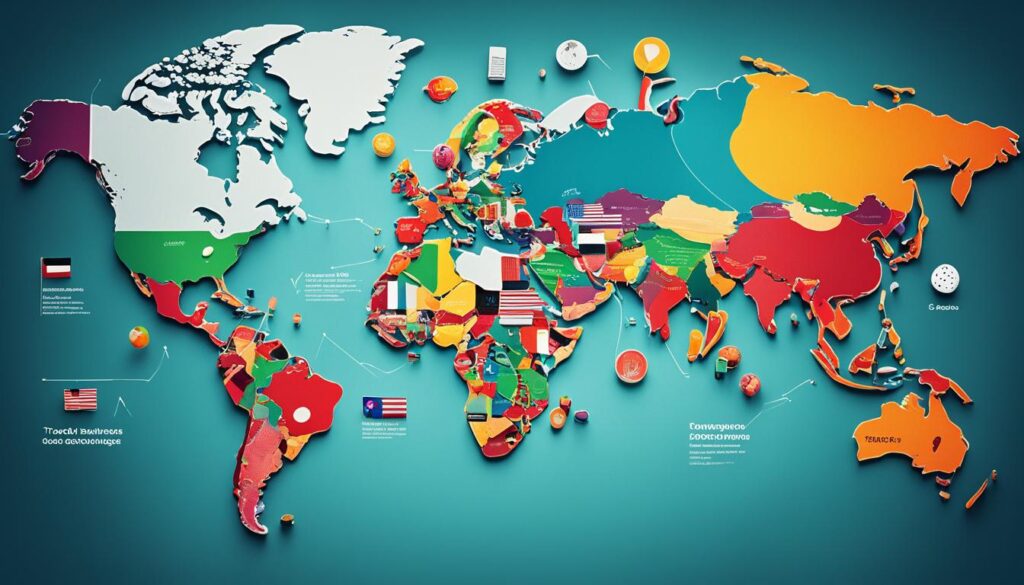
The Power of Network Approach
When examining international trade, taking a network approach allows us to uncover hidden connections and interdependencies among countries. Traditional models of trade may overlook the intricate web of relationships that shape global commerce. By studying trade networks, we gain insights into the ways nations interact, influence each other, and deal with challenges.
“Understanding international trade through a network perspective helps us grasp the complexity of global economic systems and provides a more accurate representation of trade dynamics.”
Achieving a network perspective on international trade involves utilizing sophisticated analytical methods to map and analyze economic interactions. This approach allows us to identify key players, study the patterns of trade dominance, and uncover the underlying structural properties of trade networks.
Analyzing Trade Imbalances and Dominance
Trade imbalances occur when the value of goods and services traded between nations is significantly uneven. Through network analysis, we can identify countries that consistently run trade deficits or surpluses, understand the factors contributing to these imbalances, and evaluate their implications for economic stability.
Additionally, analyzing trade dominance within networks enables us to identify countries that hold a significant share of global trade. By understanding the dynamics of trade dominance, we can assess the economic power and influence these countries exert in the global market.
The Impact of Political and Economic Crises
Political and economic crises can have profound effects on international trade. Recurrent events such as financial crises, political conflicts, and natural disasters disrupt trade flows, reshape trade networks, and create new challenges for businesses and policymakers.
By studying the impact of crises on trade networks, we can develop a better understanding of the resilience of trade relationships and identify strategies to mitigate the negative effects. Furthermore, analyzing how countries navigate through political and economic crises provides valuable lessons for improving the adaptability and resilience of trade networks in the face of future challenges.
A Comprehensive Framework for Understanding International Trade
By integrating the disciplines of international trade theory, network analysis, time-series analysis, and crisis theory, we can develop a comprehensive framework for understanding international trade dynamics. This interdisciplinary approach allows us to examine the multiple dimensions of trade, uncover hidden patterns and interdependencies, and assess the implications of global events on trade networks.
| Key Components | Description |
|---|---|
| International Trade Theory | Analyzes the principles and determinants of trade between nations. |
| Network Analysis | Visualizes and maps the relationships and interactions among countries in the trade network. |
| Time-Series Analysis | Studies trade patterns, trends, and dynamics over time to identify long-term changes and short-term fluctuations. |
| Crisis Theory | Examines the impact of political and economic crises on trade networks and the resilience of trade relationships. |
By embracing this holistic framework, we can gain a deeper understanding of international trade dynamics and develop strategies to navigate the complexities of the global marketplace.
Analyzing the Evolution of Trade Networks
In this section, I will delve into a comprehensive analysis of the evolution of trade networks among the United States, China, India, Japan, and South Korea from 1992 to 2020. By examining the structural properties of these networks, such as centrality and reciprocity, we can gain valuable insights into the changing dynamics of trade relationships between these countries.
Trade networks play a vital role in shaping global commerce, facilitating the flow of goods and services between nations. They provide a framework for understanding the interdependencies and interactions between trading partners, allowing us to identify key players and patterns within the international trade landscape.
The study focuses on two crucial aspects: centrality and reciprocity. Centrality refers to the relative importance of a country within the trade network. By analyzing centrality measures such as degree centrality, closeness centrality, and betweenness centrality, we can determine which countries hold a central position and exert significant influence in the network.
Reciprocity, on the other hand, measures the level of balance and mutual exchange in trade relationships. By quantifying the reciprocity scores between countries, we can assess the extent to which trade flows are symmetrical or skewed. This analysis helps us understand the nature of trade relationships among these nations.
To enhance our analysis, we will also study the shifts in trade dominance and the impact of major events on the trade networks. Historical events such as economic crises, political tensions, and trade policy changes can disrupt and reshape trade relationships. By evaluating these events’ influence on the trade networks, we can uncover meaningful insights into the dynamic nature of global trade.
Insights into Evolution of Trade Networks
Tracing the evolution of trade networks over nearly three decades enables us to observe how these five major economies’ trade relationships have developed and changed. By highlighting the shifts in centrality and reciprocity, we can identify emerging trade hubs, potential trading partners, and evolving patterns of economic cooperation.
The analysis will help policymakers, businesses, and researchers better understand the trade dynamics between the United States, China, India, Japan, and South Korea. It will provide insights that can inform strategic decision-making, trade policies, and international economic relations.
Next, let’s take a look at a visualization of the trade networks between these countries over the studied period:
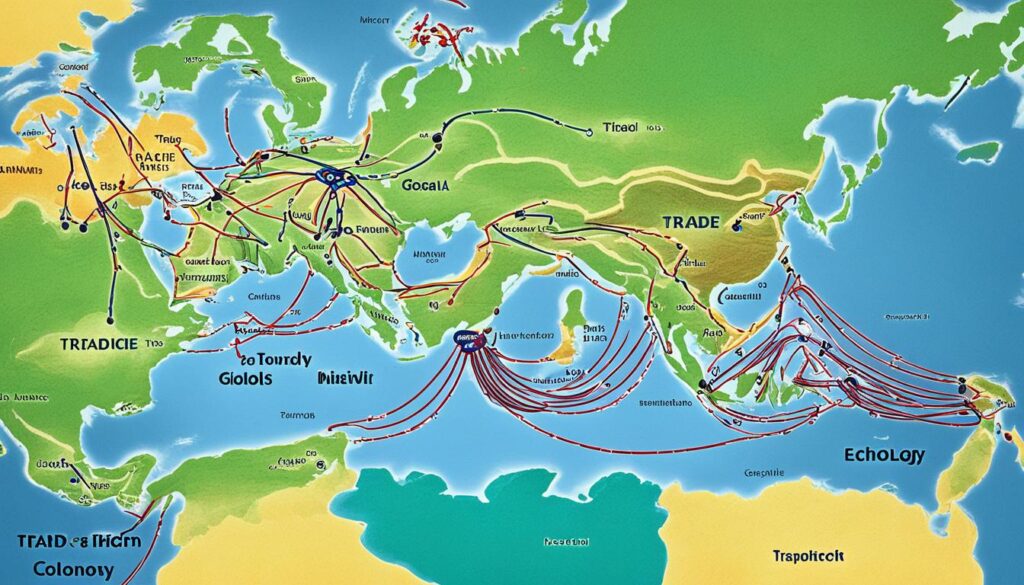
The image above illustrates the intricate web of trade relationships among the United States, China, India, Japan, and South Korea. By visualizing the trade flows and connections, we can gain a clearer understanding of how these networks have evolved and transformed over time.
In the following sections, I will further discuss the theoretical framework used to analyze these trade networks, examine global trade patterns and trends, and explore the implications of trade on economic growth, efficiency gains, income distribution, and household welfare.
Theoretical Framework for Understanding Trade Networks
The analysis of trade networks requires a robust theoretical framework that integrates various perspectives to provide a comprehensive understanding of the dynamics driving global trade. This section discusses the key components of the theoretical framework employed in this study, encompassing international trade theory, network analysis, time-series analysis, and crisis theory.
International trade theory serves as the foundation for understanding the underlying principles guiding trade dynamics. It explores concepts such as comparative advantage, factor endowments, and trade policies, offering insights into the determinants of trade flows and patterns.
Network analysis is a powerful tool for visualizing and comprehending the structure of trade relationships. By examining the interconnectedness and interdependencies of countries and their trading partners, network analysis uncovers central players, influential nodes, and the level of reciprocity within the trading network.
Time-series analysis is employed to track and analyze trade patterns over time. By charting the evolution of trade networks, this approach offers valuable insights into long-term trends, shifting alliances, and the impact of global events on trade flows.
Crisis theory explores the impact of significant global events, such as economic recessions, political conflicts, or natural disasters, on trade networks. By examining how these disruptions affect trade relationships, crisis theory helps us understand the resilience and adaptability of trade networks in times of instability.
Combining international trade theory, network analysis, time-series analysis, and crisis theory enables a holistic analysis of trade network dynamics. This interdisciplinary approach provides a deeper understanding of the intricate dynamics shaping global trade relationships and their susceptibility to various economic and geopolitical forces.
By integrating these perspectives, this study aims to shed light on the complexities and nuances of trade networks, unraveling the driving forces and uncovering the underlying patterns that shape international trade dynamics. The next section will delve into the empirical analysis of the evolution of trade networks among major trading nations.
Key Components of the Theoretical Framework
| Theoretical Perspective | Description |
|---|---|
| International Trade Theory | Serves as the foundation for understanding trade dynamics and determinants. |
| Network Analysis | Provides insights into the structure of trade relationships and the flow of goods and services. |
| Time-Series Analysis | Reveals long-term trends and patterns in trade networks. |
| Crisis Theory | Explores the impact of global events on trade networks and their resilience. |
Continue reading to gain insights into the evolution of trade networks among major trading nations and the implications for global economic relations.
Shifts in Global Trade Patterns and Trends
Global trade patterns and trends have undergone significant shifts driven by a range of factors. These changes have reshaped the international trade landscape and had profound implications for businesses. To stay competitive in this dynamic environment, understanding and adapting to these trends is crucial.
The Rise of Emerging Markets
Emerging markets have emerged as key players in global trade. Countries such as China, India, Brazil, and Indonesia have experienced rapid economic growth, driving an increase in trade volumes and market opportunities. These markets offer new consumer bases, production capabilities, and investment prospects. Businesses need to recognize the potential of emerging markets and develop strategies to tap into their growth.
The Evolution of Trade Agreements
Trade agreements have played a pivotal role in shaping global trade patterns. With the advent of regional trade agreements like the European Union and ASEAN, trade barriers have diminished, fostering greater cross-border trade. Additionally, mega-trade agreements such as the Comprehensive and Progressive Agreement for Trans-Pacific Partnership (CPTPP) and the Regional Comprehensive Economic Partnership (RCEP) have further deepened regional integration. Businesses must navigate and leverage these agreements to expand their market access and unlock new business opportunities.
The Growth of Digital Trade
Digital trade, driven by e-commerce and digitalization, has revolutionized global trade. The expansion of online platforms and technology-enabled services has created new avenues for trade, allowing businesses to reach consumers worldwide. The COVID-19 pandemic has accelerated the adoption of digital trade, making it more essential than ever. To capitalize on this trend, businesses need to embrace digital technologies and develop robust e-commerce strategies.
Trade Wars and Protectionism
Trade wars and protectionist measures have disrupted global trade flows. Rising tensions between major economies, such as the United States and China, have led to the imposition of tariffs and trade restrictions. These measures have introduced uncertainty and increased costs for businesses. Companies must closely monitor trade policies and anticipate potential impacts to mitigate risks and explore alternative markets.
The Focus on Sustainability
Sustainability has become a key consideration in global trade. Increasingly, consumers and governments demand environmentally responsible practices, forcing businesses to integrate sustainability into their supply chains. This shift towards sustainable trade encompasses areas such as renewable energy, carbon footprint reduction, and responsible sourcing. By embracing sustainability practices, businesses can enhance their brand reputation, meet regulatory requirements, and tap into the growing market for eco-friendly products and services.
Advancements in Technology
Technological advancements have revolutionized global trade by enabling faster, more efficient, and cost-effective transactions. Technologies such as blockchain, artificial intelligence, and Internet of Things (IoT) have enhanced supply chain visibility, streamlined logistics, and facilitated trade finance. To remain competitive, businesses must embrace these technologies to optimize their operations, reduce trade barriers, and enhance customer experiences.
The Growth of Services Trade
Services trade has become an increasingly integral part of global commerce. Traditionally dominated by goods, international trade now encompasses services such as finance, tourism, education, and telecommunication. The liberalization of services trade has opened new avenues for businesses to expand globally. Organizations should seek opportunities to participate in the growing services trade sector and develop strategies to capitalize on the increasing demand for cross-border services.
The Reshaping of Global Value Chains
The traditional concept of global value chains has evolved, driven by shifting production processes and market dynamics. Businesses now operate in complex networks with interdependent connections across different countries and regions. This reshaping of value chains presents both challenges and opportunities. To thrive in this environment, companies need to optimize their value chain configurations, collaborate effectively with suppliers and partners, and adapt to changing market dynamics.
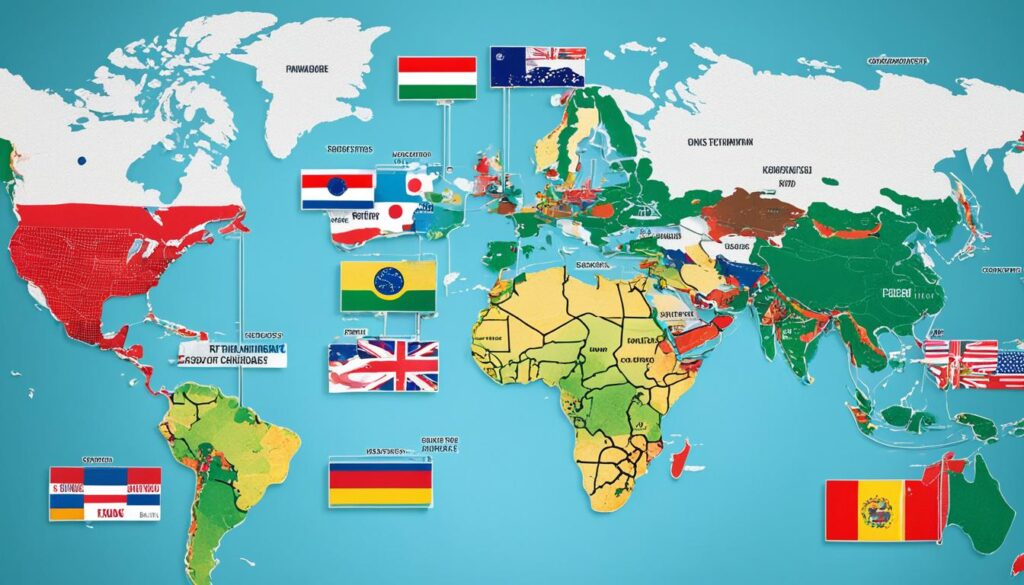
The Impact of Globalization on Trade Growth
Globalization has had a profound impact on the growth of international trade. Over the past century, the value of world exports has experienced significant growth, and the trade sector has expanded at a rate faster than the overall GDP. The integration of national economies into the global economic system has played a crucial role in facilitating trade growth and contributing to positive economic development.
As countries have opened up their borders to global trade, the exchange of goods and services has flourished, leading to increased economic interdependence and global economic integration. Trade has become a driving force behind global economic growth, fostering closer ties among nations and creating opportunities for businesses to expand their market reach.
There is a strong positive correlation between trade and GDP growth, both at the country level and the firm level. As countries engage in international trade, they experience improved economic performance and higher levels of productivity. Trade stimulates competition, innovation, and specialization, all of which contribute to higher levels of economic output.
Furthermore, trade has played a vital role in driving global economic integration. By promoting the flow of goods, services, capital, and technology across borders, trade has facilitated the sharing of knowledge and resources, leading to increased efficiency and productivity. It has allowed countries to capitalize on their comparative advantages and participate in global value chains, opening up new opportunities for growth and development.

Impact of Trade on GDP Growth
Trade has a direct and measurable impact on GDP growth. Studies have consistently shown that countries with higher levels of trade relative to their GDP tend to experience faster economic growth rates. This relationship holds true across various sectors and industries.
\”The trade-GDP relationship is not only backed by empirical evidence but also supported by economic theory. Trade allows countries to exploit their comparative advantages and specialize in the production of goods and services that they can produce most efficiently. This specialization leads to higher productivity levels and ultimately drives GDP growth.\”
Moreover, the relationship between trade and economic growth extends beyond the country level. Firms that engage in trade activities also tend to experience higher levels of growth and profitability. Trade opens up new markets, providing businesses with access to a larger customer base, increased sales opportunities, and potential for economies of scale.
Trade as a Driver of Economic Development
Trade has been a powerful driver of economic development, particularly for developing countries. By participating in global trade, these nations are able to tap into global markets, attract foreign investment, and gain access to new technologies and knowledge. This not only promotes economic growth but also helps to reduce poverty and improve living standards.
Trade liberalization and the removal of trade barriers have played a key role in facilitating trade growth and economic development. Through trade agreements and negotiations, countries have been able to create an enabling environment for trade, fostering cooperation, and promoting global economic integration. The World Trade Organization (WTO) and regional trade agreements have played crucial roles in reducing tariffs, easing trade restrictions, and creating a more favorable trade environment.
| Key Factors | Impact on Trade Growth |
|---|---|
| Removal of Trade Barriers | Enhanced market access and increased trade volumes |
| Technological Advancements | Facilitated cross-border communication, increased efficiency, and expanded trade opportunities |
| Global Value Chains | Promoted specialization, increased productivity, and facilitated access to inputs and services |
| Emerging Markets | Opened up new trade routes and provided growth opportunities for businesses |
\”The growth of trade has been instrumental in connecting economies and fostering global economic integration. It has created a network of interdependencies, where countries rely on each other for goods, services, and resources. This interconnectedness has not only facilitated economic growth but also promoted peace and cooperation among nations.\”
To fully harness the benefits of globalization and trade growth, policymakers and businesses must focus on creating an enabling environment that promotes fair and inclusive trade. By addressing issues of income inequality, ensuring the sustainability of global supply chains, and fostering technological advancements, countries can maximize the positive impact of trade on economic development.
Trade, Efficiency Gains, and Productivity
Trade liberalization plays a crucial role in enhancing economic efficiency and boosting productivity. Numerous studies have consistently indicated that increased trade openness leads to innovation, efficiency gains, and learning, ultimately driving economic growth. By removing trade barriers, nations can create an environment that fosters competition and encourages firms to improve their efficiency and productivity in order to stay competitive in the global market.
One of the key outcomes of trade liberalization is the stimulation of cross-country differences in terms of resources, technology, and specialization. Countries can leverage their comparative advantages to engage in trade and benefit from the expertise and resources available in other nations. This allows firms to access a wider range of inputs, knowledge, and technologies, leading to improvements in firm-level productivity.
The impact of trade on GDP growth can be assessed through various methodologies, including instrumental variable approaches and cross-country data analysis. These studies provide evidence that trade does generate efficiency gains and contributes to overall economic growth. Trade has a positive effect on GDP growth by promoting technological progress, encouraging resource allocation efficiency, and facilitating consumer access to a wider variety of goods and services.
Benefits of Trade Liberalization:
- Enhanced economic efficiency
- Increased productivity and innovation
- Stimulation of cross-country differences
- Fostering of learning and knowledge sharing
- Expanded consumer choice and access to goods and services
The positive impact of trade on economic efficiency, productivity, and GDP growth highlights the importance of trade liberalization as a driver of economic development. By embracing free trade policies and reducing trade barriers, nations can unlock the potential for greater efficiency gains and foster sustainable economic growth.
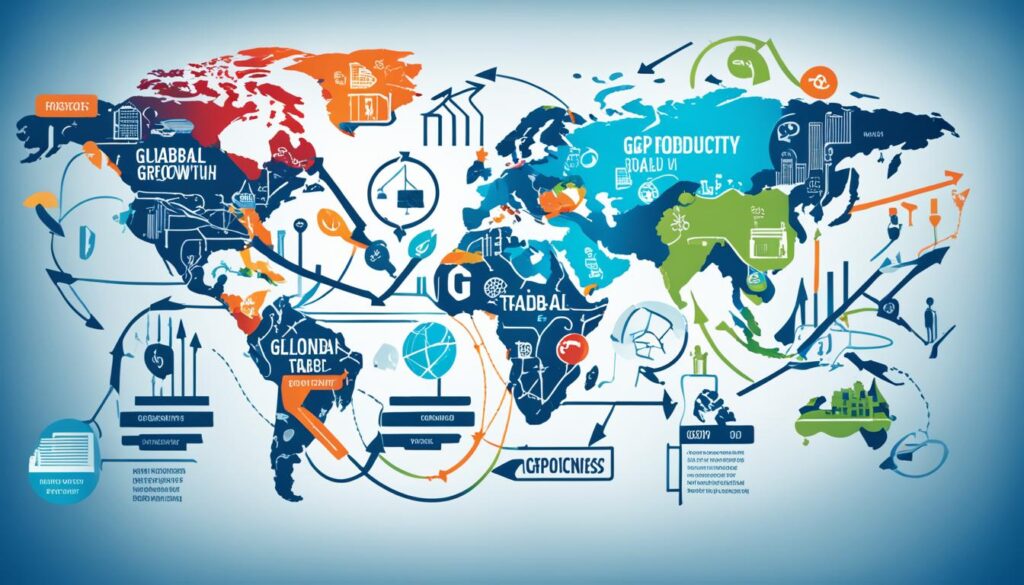
The Key Takeaway:
“Trade liberalization leads to enhanced economic efficiency, improved productivity, and positive impacts on GDP growth. Greater trade openness enables countries to benefit from specialization, access resources and technologies, and stimulate innovation. By embracing free trade policies, nations can unlock their potential for long-term economic growth and prosperity.”
Distributional Effects of Trade
When considering the impact of trade, it is important to examine its distributional effects. While trade can generate overall efficiency gains and promote economic growth, the benefits are not equally shared among individuals and groups. This section explores the link between trade and income inequality, as well as the effects on wages and employment.
The Link between Trade and Income Inequality
Evidence suggests that trade can contribute to income inequality. Studies have shown that trade liberalization, while promoting economic efficiency, can lead to wage stagnation for certain segments of the population. In particular, workers in industries that face competition from imports may experience reduced wages and job insecurity. This phenomenon has been evident in various sectors, including manufacturing and agriculture, where competition from lower-cost imports has put pressure on domestic industries.
Furthermore, the distributional effects of trade can vary across countries and regions. Developing economies that rely heavily on low-skilled labor may experience a widening income gap as trade allows for the relocation of industries to countries with lower labor costs. On the other hand, advanced economies with a strong emphasis on knowledge-intensive industries may benefit from trade through higher wages for skilled workers but may exacerbate income inequality by leaving low-skilled workers at a disadvantage.
Impact on Wages and Jobs
Trade can also have significant effects on wages and employment. The influx of imports, particularly from countries with lower labor costs, can displace workers in industries that face intense international competition. Research has shown that Chinese imports, in particular, have led to job losses and wage declines for manufacturing workers in the United States. The increase in import competition from China resulted in the displacement of millions of jobs and downward pressure on wages in affected industries.
“The impact of Chinese imports on the US manufacturing sector highlights the vulnerabilities faced by workers in the face of rapidly changing global trade dynamics.” – [Author Name]
It is important to note that the impact on wages and jobs varies across industries and regions. While some workers may experience negative effects, trade also creates opportunities for employment and wage growth in industries that benefit from increased export opportunities or access to cheaper imports.
Addressing Distributional Concerns
To ensure that the gains from trade are fairly distributed, policymakers need to address distributional concerns. This can be achieved through a combination of policies and measures aimed at supporting affected workers and promoting inclusive growth. These may include:
- Investing in education and retraining programs to equip workers with the skills needed for emerging sectors and industries
- Implementing social safety nets and income support programs to assist workers who are temporarily or permanently displaced
- Encouraging investment in industries with high wage potential and promoting innovation and technological advancement
- Strengthening labor market institutions to ensure fair wages, job security, and worker rights
The Link between Trade and Household Welfare
Trade has a profound impact on households, influencing both their consumption patterns and wages. Changes in trade dynamics can have significant effects on the prices of goods and services, directly impacting the purchasing power of households. Additionally, trade has an indirect effect on wages, as it shapes the demand for different types of workers in the labor market.
The relationship between trade, prices, and wages is complex and multifaceted. Economic theories, such as general equilibrium consumption effects and general equilibrium income effects, help us understand the intricate interplay between these factors and their implications for household welfare. However, it’s important to note that the effects of trade on households are not uniform across different groups of people.
For some households, trade can bring about opportunities for higher-quality and lower-priced goods, leading to increased consumption and improved standards of living. On the other hand, trade can also result in job displacement and wage effects for certain sectors or workers. The impact of trade on household welfare depends on various factors such as skill levels, education, industry exposure, and geographical location.
“Trade can have both winners and losers, and understanding the distributional effects is crucial for designing policies that maximize the benefits of global trade while minimizing its negative consequences.”
Research has shown that the impact of trade on wages is heterogeneous, with both positive and negative effects observed across different industries and occupations. Import competition, for example, can lead to downward pressure on wages in sectors that face strong competition from low-cost producers. Conversely, trade can also create new job opportunities and increase wages in industries that benefit from increased export demand or access to foreign markets.
Furthermore, the effects of trade on household welfare extend beyond consumption and wages. Trade can also influence the availability of goods and services in the domestic market, affecting the overall quality of life. It can drive technological advancements and innovation, leading to the development of new products and services that enhance household well-being.
To illustrate the link between trade and household welfare, consider the impact of trade on prices. As countries engage in trade, they can access a wider range of goods from different parts of the world. Increased competition from foreign producers can put downward pressure on prices, resulting in cost savings for households. This, in turn, can lead to increased affordability and greater access to a variety of goods and services.
On the other hand, trade can also have price-increasing effects. For example, when tariffs or trade restrictions are imposed, the cost of imported goods may rise, leading to higher prices for consumers. Additionally, trade-related factors such as transportation costs, exchange rate fluctuations, and supply chain disruptions can influence prices. Understanding these dynamics is vital for policymakers and businesses to make informed decisions that support household welfare.
Conclusion
Understanding global trade dynamics and trade trends is essential for businesses and policymakers in today’s interconnected world. By analyzing trade networks and staying informed about the impact of globalization on trade growth, businesses can seize opportunities and adapt their strategies to thrive in the ever-changing landscape of international trade.
It is crucial to recognize the economic implications of global trade. Businesses need to consider the distributional effects of trade and take steps to address concerns related to income inequality. By ensuring fair distribution of the gains from trade, companies can contribute to a more sustainable and inclusive global economy.
Business strategies must be tailored to the dynamic nature of global trade. The ability to adapt to shifting trade patterns, emerging markets, and technological advancements is paramount. Flexibility and adaptability enable businesses to navigate the complexities of international trade and seize competitive advantages.
In conclusion, a comprehensive understanding of global trade dynamics empowers businesses to make informed decisions and develop effective strategies. By staying abreast of trade trends and embracing adaptability, businesses can position themselves for success in the global marketplace.
